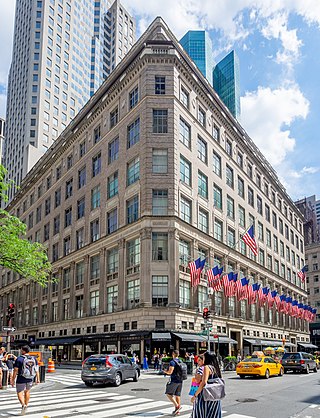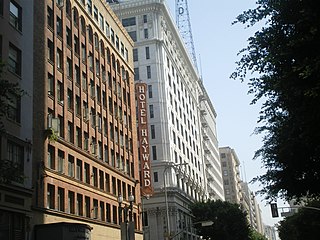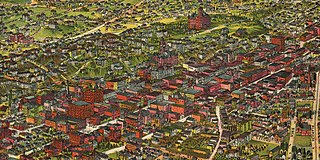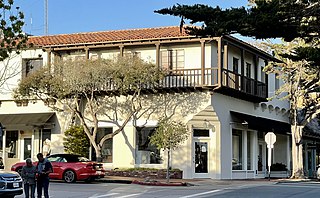
Saks Fifth Avenue is an American luxury department store chain headquartered in New York City and founded by Andrew Saks. The original store opened in the F Street shopping district of Washington, D.C. in 1867. Saks expanded into Manhattan with its Herald Square store in 1902 and flagship store on Fifth Avenue in 1924. The chain was acquired by Tennessee-based Proffitt's, Inc. in 1998, and Saks, Inc. was acquired by the Canadian-based Hudson's Bay Company (HBC) in 2013.

Canal Street is a major thoroughfare in the city of New Orleans. Forming the upriver boundary of the city's oldest neighborhood, the French Quarter or Vieux Carré, it served historically as the dividing line between the colonial-era (18th-century) city and the newer American Sector, today's Central Business District.
Marshall Field & Company was an upscale department store in Chicago, Illinois. Founded in the 19th century, it grew to become a large chain before Macy's, Inc acquired it in 2005. Its eponymous founder, Marshall Field, was a pioneering retail magnate.

Newbury Street is located in the Back Bay area of Boston, Massachusetts, in the United States. It runs roughly east–west, from the Boston Public Garden to Brookline Avenue. The road crosses many major arteries along its path, with an entrance to the Massachusetts Turnpike westbound at Massachusetts Avenue. Newbury Street is a destination known for its many retail shops and restaurants.

Downtown Crossing is a shopping district within downtown Boston, Massachusetts, located east of Boston Common, west of the Financial District, south of Government Center, and north of Chinatown and the old Combat Zone. It features large department stores as well as restaurants, souvenir sellers, general retail establishments, and street vendors. The Downtown Crossing MBTA station lies in the center of the district.
S. H. Kress & Co. was the trading name of a chain of five and dime retail department stores in the United States established by Samuel Henry Kress. It operated from 1896 to 1981. In the first half of the 20th century, there were Kress stores with ornamented architecture in hundreds of cities and towns.

Broadway, until 1890 Fort Street, is a thoroughfare in Los Angeles County, California, United States. The portion of Broadway from 3rd to 9th streets, in the Historic Core of Downtown Los Angeles, was the city's main commercial street from the 1910s until World War II, and is the location of the Broadway Theater and Commercial District, the first and largest historic theater district listed on the National Register of Historic Places (NRHP). With twelve movie palaces located along a six-block stretch of Broadway, it is the only large concentration of movie palaces left in the United States.

The Washington Avenue Historic District is located in Downtown West, St. Louis, Missouri along Washington Avenue, and bounded by Delmar Boulevard to the north, Locust Street to the south, 8th Street on the east, and 18th Street on the west. The buildings date from the late 19th century to the early 1920s. They exhibit a variety of popular architectural styles of those years, but most are revival styles or in the commercial style that would later come to be known as the Chicago School of architecture. Most are large multi-story buildings of brick and stone construction, built as warehouses for the St. Louis garment district. Many have terra cotta accents on their facades. After World War II, the decline in domestic garment production and the preference for single-story industrial space led to many of the buildings being vacant or underused due to functional obsolescence.

One Canal Place, located at 365 Canal Street in the Central Business District of New Orleans, Louisiana, is a 32-story, 440 feet (134 m)-tall skyscraper. The building contains The Shops at Canal Place and is attached to the Westin New Orleans Canal Place hotel, with which it shares a parking garage.


The Marshall Field and Company Building is a National Historic Landmark retail building on State Street in Chicago, Illinois. Now housing, Macy's State Street, the Beaux-Arts and Commercial style complex was designed by architect Daniel Burnham and built in two stages—north end in 1901–02 and south end in 1905–06. It was the flagship location of the Marshall Field and Company and headquarters Marshall Field's chain of department stores. Since 2006, it is the main Chicago mid-western location of the Macy's department stores. The building is located in the Chicago "Loop" area of the downtown central business district and it takes up the entire city block bounded clockwise from the west by North State Street, East Randolph Street, North Wabash Avenue, and East Washington Street. Field and partners founded their Chicago store in 1852, and first built an expansive shopping emporium on this site in 1868. The 1901 building was the fourth for the department store at this site.

Spring Street in Los Angeles is one of the oldest streets in the city. Along Spring Street in Downtown Los Angeles, from just north of Fourth Street to just south of Seventh Street is the NRHP-listed Spring Street Financial District, nicknamed Wall Street of the West, lined with Beaux Arts buildings and currently experiencing gentrification. This section forms part of the Historic Core district of Downtown, together with portions of Hill, Broadway, Main and Los Angeles streets.

The O'Kane Building is a historic commercial building in Bend, Oregon, United States. The structure was built in 1916 by Hugh O'Kane, a local businessman. The two-story building is located downtown on the west corner of Oregon Avenue and Bond Street.

The New Center Commercial Historic District is a commercial historic district located on Woodward Avenue between Baltimore Street and Grand Boulevard in Detroit, Michigan. It was listed on the National Register of Historic Places in 2016.

Minneapolis City Center is a mixed-use shopping mall on Nicollet Mall in Minneapolis, Minnesota. It opened in 1983 and occupies the bottom three floors of the 33 South Sixth office building. Designed by Skidmore, Owings & Merrill, Minneapolis City Center contains 250,000 square feet (23,000 m2) of leasable retail space. The mall was built around the pre-existing Forum Cafeteria restaurant. The building is adjacent to the Marriott Hotel City Center and connected to the Gaviidae Common shopping mall.

The late-Victorian-era Downtown of Los Angeles in 1880 was centered at the southern end of the Los Angeles Plaza area, and over the next two decades, it extended south and west along Main Street, Spring Street, and Broadway towards Third Street. Most of the 19th-century buildings no longer exist, surviving only in the Plaza area or south of Second Street. The rest were demolished to make way for the Civic Center district with City Hall, numerous courthouses, and other municipal, county, state and federal buildings, and Times Mirror Square. This article covers that area, between the Plaza, 3rd St., Los Angeles St., and Broadway, during the period 1880 through the period of demolition (1920s–1950s).

Parts of F Street and 7th Street, N.W. and nearby blocks have historically been the heart of the Washington, D.C. Downtown shopping district. In the first half of the 20th century there were numerous upscale large department stores along and near F Street, while 7th Street housed more economical emporia and large retail furniture stores. The F street corridor stretches west from Downtown's Penn Quarter and Gallery Place towards 15th Street, while the 7th Street corridor includes the neighborhoods of Penn Quarter, Chinatown and Mount Vernon Square, and extends up to the border of Shaw.

The Saks Fifth Avenue flagship store is a department store in Midtown Manhattan, New York City on Fifth Avenue between 49th and 50th Streets. The original 10-story structure at 611 Fifth Avenue has served as the flagship store of Saks Fifth Avenue since its completion in 1924. The store also occupies part of 623 Fifth Avenue, a 36-story tower completed in 1990.

The Goold Building is a historic two-story concrete commercial building in downtown Carmel-by-the-Sea, California. The building is an example of Spanish Colonial Revival and Monterey Colonial styles. The building qualified as an important commercial building in the city's downtown historic district property survey and was registered with the California Register of Historical Resources on February 3, 2003. The building has occupied the Coach Outlet since the 1990s.

The Doud Building, also known as the James Doud Building is a historic commercial building in Carmel-by-the-Sea, California. James Cooper Doud established the building in 1932, built by master builder Michael J. Murphy as a mixed-use retail shop and residence. It is an example of a Spanish Colonial Revival architecture style building. The structure is recognized as an important commercial building in the city's Downtown Conservation District Historic Property Survey, and was nominated and submitted to the California Register of Historical Resources on February 21, 2003. The building is now occupied by the Mad Dogs & Englishmen Bike Shop and the Carmel Sport clothing store.
















